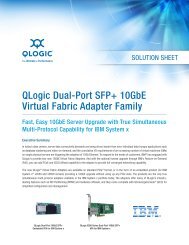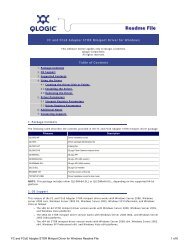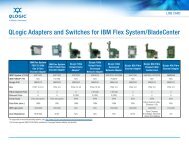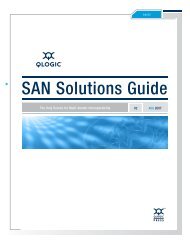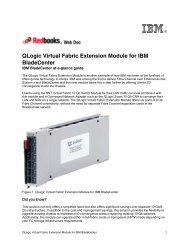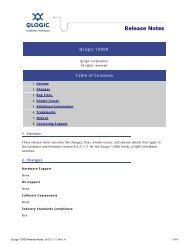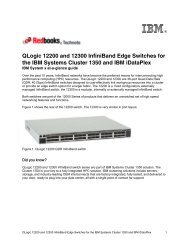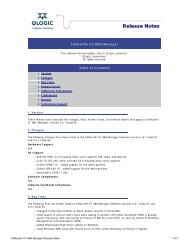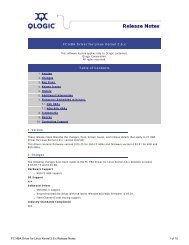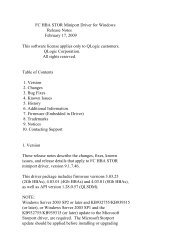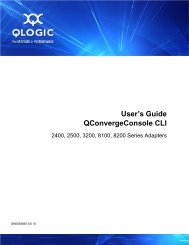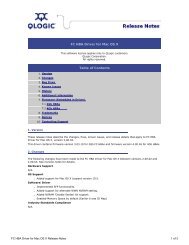IP over FC NDIS Miniport Driver Readme File - QLogic
IP over FC NDIS Miniport Driver Readme File - QLogic
IP over FC NDIS Miniport Driver Readme File - QLogic
- No tags were found...
Create successful ePaper yourself
Turn your PDF publications into a flip-book with our unique Google optimized e-Paper software.
<strong>IP</strong> <strong>over</strong> <strong>FC</strong> <strong>NDIS</strong> SCSI <strong>Miniport</strong> Windows <strong>Driver</strong>This software license applies only to <strong>QLogic</strong> customers.<strong>QLogic</strong> Corporation.All rights reserved.Table of Contents1. OS Support2. Supported Features3. Release History4. Creating the <strong>Driver</strong> Diskette5. Installing the <strong>Driver</strong>5.1. Installing the <strong>Driver</strong> on Windows Server 20035.2. Updating the <strong>Driver</strong> on Windows Server 20036. Uninstalling the <strong>Driver</strong> on Windows Server 20037. <strong>Driver</strong> Parameters7.1. Setting <strong>Driver</strong> Parameters on Windows 20008. Release Content9. Additional Notes10. Contacting Support1. OS SupportThis driver was tested on Windows Server 2003 (SP1/R2) 32-bit and 64-bit Itanium platforms. Earlier versions ofWindows Server 2003 are not supported.
2. Supported Features●●●●●●Provides standard Ethernet functionalitySupports tunable MTU size up to 65280 bytesSupports tunable data buffer size and countSupports multiple adapters per systemSupports simultaneous <strong>IP</strong> and disk IO <strong>over</strong> same Fibre Channel linkSupports QLA23xx and QLx24xx <strong>FC</strong> HBAs3. Release HistoryPlease refer to the Release Notes provided in the package content.4. Creating the <strong>Driver</strong> Disk or Folder1. Locate the driver you want on the <strong>QLogic</strong> website and click Link to driver.2. If prompted What would you like to do with this file? choose Save this program to disk. Specify atemporary location on the hard drive and download the driver.3. Insert a blank diskette in the diskette drive A:.4. Run the self-extracting file you just downloaded specifying A:\ in the Unzip To Folder: field.5. Installing the <strong>Driver</strong>IMPORTANT requirements for installing and using the QL2X00<strong>IP</strong> driver:●●●Must have the enhanced version (<strong>IP</strong> or VI) of the SCSI <strong>Miniport</strong> driver installed. The QL2X00<strong>IP</strong> <strong>NDIS</strong> driverwill NOT function with the standard version of the SCSI <strong>Miniport</strong> driver.The Windows Networking software must be installed.The MTU size (<strong>IP</strong> configuration parameter) must be set to the same value for all adapters on the network.This section is divided into the following sections:● 5.1. Installing the <strong>Driver</strong> on Windows Server 2003● 5.2. Updating the <strong>Driver</strong> on Windows Server 20035.1. Installing the <strong>Driver</strong> on Windows Server 2003To install the driver on an existing Windows Server 2003 system, follow these steps:1. Click on Start.2. Under Control Panel, click on Add Hardware.3. Click Next.4. Select Yes, I have already connected the hardware and click Next.5. Select Add a new hardware device and click Next.6. Select Install the hardware that I manually select ... and click Next.7. Select Network adapters and click Next.
8. Click on Have Disk.9. Insert the <strong>QLogic</strong> software diskette.10. Enter the path to the network driver and click OK.11. Choose <strong>QLogic</strong> QLA2X00 PCI Adapter and click Next.12. Click Next to install the driver.13. Click Continue Anyway to continue installation.14. Click Finish.5.2. Updating the <strong>Driver</strong> on Windows Server 2003If the driver is already installed and you want to install an updated version of the driver on Windows Server 2003,follow these steps:1. Click on Start.2. Under Administrative Tools, click on Computer Management.3. Select Device Manager and open list of Network adapters.4. Double click on the <strong>QLogic</strong> QLA2X00 PCI Adapter.5. Select the <strong>Driver</strong> tab and click on Update <strong>Driver</strong>.6. Click Next to continue.7. Select Install from a list or specific location and click Next.8. Select Don't search, I will choose the driver... and click Next.9. Click on Have Disk.10. Insert the <strong>QLogic</strong> software diskette.11. Enter the path to the network driver and click OK.12. Choose <strong>QLogic</strong> QLA2X00 PCI Adapter and click Next.13. Click Next to install the driver.14. Click Continue Anyway to continue installation.15. Click Finish.6. Uninstalling the <strong>Driver</strong> on Windows Server 2003To uninstall the <strong>QLogic</strong> <strong>IP</strong> driver on Windows Server 2003, follow these steps:1. Click on Start.2. Under Control Panel->Network Connections, select the Local Area Connection for the <strong>QLogic</strong> adapter.3. Click on Properties.4. Click on Configure and select the <strong>Driver</strong> tab.5. Click on Uninstall and click OK to continue.
7. <strong>Driver</strong> Parameters<strong>IP</strong> Configuration ParametersParameterMTU SizeBuffer CountBuffer SizeHeader Split SizeDescriptionSpecifies the maximum transfer size or packet size that the host system will send or receive. All systems on thenetwork must be set to the same MTU size. The MTU size minimum value is 140 and the maximum value is65280. The recommended default value is 8192.Specifies the number of receive buffers that are allocated by the QL2X00<strong>IP</strong> driver during initialization. Thenumber of buffers multiplied by the buffer size must be at least as large as the MTU size. The minimum buffercount is 8 and the maximum buffer count is 128. The recommended default is 32 buffers.Specifies the size of each receive buffer. The buffer size multiplied by the buffer count must be at least as largeas the MTU size. Incoming packets can not be broken into more than 23 buffers. Therefore, the buffer sizemultiplied by 23 must be at least as large as the MTU size. The minimum buffer size is 512 and the maximumsize is 65536. The recommended default buffer size is 4096.Specifies the number of bytes at the start of an incoming packet that are to be isolated in the 1st receive buffer.This allows an application to receive a packet with the protocol header already separated from the data. Theminimum non-zero value is 24 and the maximum value is the buffer size minus 1. The recommended default is 0(no header/data split).Adapter Port Name Specifies the world wide name of the <strong>QLogic</strong> adapter to use for this <strong>IP</strong> connection. This parameter is optionaland is not required on systems with only one <strong>QLogic</strong> adapter. The <strong>QLogic</strong> Fast!UTIL utility can be used todetermine the node names for all adapters in the system.7.1. Setting <strong>Driver</strong> Parameters on Windows 2000To set the <strong>IP</strong> address on Windows 2000 or to change any of the parameters described above, follow these steps:1. Click on Start.2. Under Settings, click on Network and Dial-up Connections.3. Right-click on Local Area Connection for the <strong>QLogic</strong> adapter and click on Properties.4. Use Internet Protocol (TCP/<strong>IP</strong>) Properties button to set up the <strong>IP</strong> address.5. Click on Configure and select the Advanced tab to change the <strong>QLogic</strong> driver parameters that are describedabove.8. Release ContentThe following table lists and describes the Windows support files included in the driver installation package:<strong>Driver</strong> Contents<strong>File</strong>NETQL2X.INFQL2X00<strong>IP</strong>.SYSRELEASE.TXTREADME.TXTDescription<strong>Driver</strong> installation script for the Windows<strong>QLogic</strong> QL2X00<strong>IP</strong> <strong>NDIS</strong> driver for WindowsRelease notes for QL2X00<strong>IP</strong> driverHelpful hints about the driver
9. Additional NotesDefault frame size for QLA23xx/QLx24xx is 2048.10. Contacting SupportPlease feel free to contact your <strong>QLogic</strong> approved reseller or <strong>QLogic</strong> Technical Support at any phase of integration forassistance. <strong>QLogic</strong> Technical Support can be reached by the following methods:Web: http://support.qlogic.comNorth America Contact InformationEmail: support@qlogic.comPhone: (952) 932-4040Support contact information for other regions of the world is available at the <strong>QLogic</strong> website:http://support.qlogic.comGo to Top© Copyright 2006. All rights reserved worldwide. <strong>QLogic</strong>, the <strong>QLogic</strong> logo, and the Powered by <strong>QLogic</strong> logo areregistered trademarks of <strong>QLogic</strong> Corporation. All other brand and product names are trademarks or registeredtrademarks of their respective owners.



